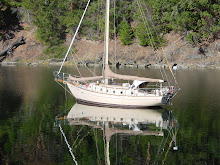Puerto Refugio, BC, Mexico
Well, we made the break from Bahia de los Angeles, at last. We have traveled some 40 miles further north to the tip of Isla Angel de la Guarda, the most northerly island of any size in the Sea of Cortez. It was a windless journey, motoring the entire way, helped for most of the way by a following current - a very pleasant trip.
Puerto Refugio is a very picturesque and secluded anchorage which is surrounded by various very rugged islands and rocky islets, lending themselves to snorkeling and diving. The anchorage itself is quite large and mostly open to the north - not a place you want to be in north wind and waves. The main bay is divided by reefs into three bights, the west, middle and east, of which the middle is the largest and has the least hazards. So of course it was the middle bight we headed for.
When we anchored, there were 2 boats in the west bight, 3 boats in the east bight and 3 other boats in the middle bight with us - a busy place. After a very calm night, all but 3 of the boats left, including everyone from the middle bight except us, heading for various points south. As usual, our appearance has prompted everyone to leave.
We had a lovely day, taking the dinghy over to the nearby Isla Granito, on which a sea lion rookery can be found. It was an incredible experience to float down the coast of this island with sea lions swimming around us, watching mothers with their pups and occasionally being threatened by the big bulls out to protect their harems. Back nearer the boat, we did some snorkeling along one of the reefs, followed by a brief swim in the late afternoon - a pretty perfect day.
Last night, around 2 AM, a nasty swell started to roll into the anchorage, making us rock and roll around and making it difficult to sleep. In the morning, the remainder of the boats still in the anchorages, either left or moved to a smaller western bay to try and get away from the swell. We elected instead to just move to the western bight of this bay to see if it was any better there. By the time we successfully got the anchor set (took 3 tries), the swell had pretty well abated, so it is hard to say if this was a good decision or not. We shall see tonight.
Meanwhile, the big issue is hurricane Hilary, which is currently churning away down south of Cabo San Lucas. A lot of the weather gurus are predicting that this could be a bad one for the Baja. Hurricanes this late in the season have a tendency to turn north, following the outside of the Baja peninsula, then sometimes turning east to cross the peninsula and into the Sea of Cortez in the northern portion, right where we and all of the other boats are currently spread out. It is too early to tell just yet what we will do if it looks like it is heading our way. We could head back south to Puerto Don Juan, or we could try going another 45 miles north to Willard bay, the only other reasonable hurricane hole on this coast. It was our hope that Puerto Refugio would be the furthest north point we would be going this summer, but time will tell. Here is hoping!
{GMST}29|32.33|N|113|33.4|W|Puerto Refugio, BC, Mexico|Puerto Refugio, BC, Mexico{GEND}











